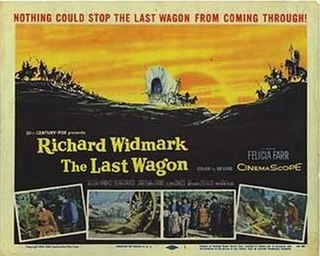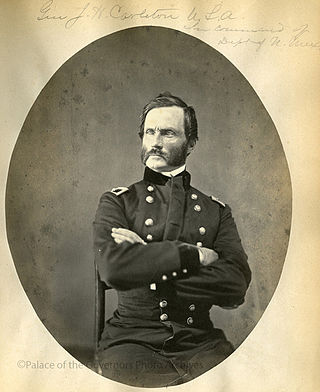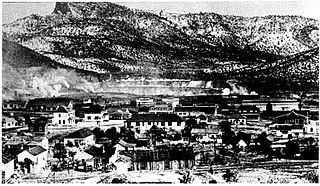
Chiricahua is a band of Apache Native Americans.

Cochise was the leader of the Chiricahui local group of the Chokonen and principal nantan of the Chokonen band of a Chiricahua Apache. A key war leader during the Apache Wars, he led an uprising that began in 1861 and persisted until a peace treaty was negotiated in 1872. Cochise County is named after him.

Victorio was a warrior and chief of the Warm Springs band of the Tchihendeh division of the central Apaches in what is now the American states of Texas, New Mexico, Arizona, and the Mexican states of Sonora and Chihuahua.

The Apache Wars were a series of armed conflicts between the United States Army and various Apache tribal confederations fought in the southwest between 1849 and 1886, though minor hostilities continued until as late as 1924. After the Mexican–American War in 1846, the United States inherited conflicted territory from Mexico which was the home of both settlers and Apache tribes. Conflicts continued as new United States citizens came into traditional Apache lands to raise livestock and crops and to mine minerals.

The Battle of Apache Pass was fought in 1862 at Apache Pass, Arizona, in the United States, between Apache warriors and the Union volunteers of the California Column as it marched from California to capture Confederate Arizona and to reinforce New Mexico's Union army. It was one of the largest battles between the Americans and the Chiricahua during the Apache Wars.

Mangas Coloradas or Mangus-Colorado, or Dasoda-hae was an Apache tribal chief and a member of the Mimbreño (Tchihende) division of the Central Apaches, whose homeland stretched west from the Rio Grande to include most of what is present-day southwestern New Mexico. He was the father-in-law of Chiricahua (Tsokanende) chief Cochise, Mimbreño chief Victorio, and Mescalero (Sehende) chief Kutu-hala or Kutbhalla. He is regarded as one of the most important Native American leaders of the 19th century because of his fighting achievements against the Mexicans and Americans.

Seven Men from Now is a 1956 American Western film directed by Budd Boetticher and starring Randolph Scott, Gail Russell and Lee Marvin. The film was written by Burt Kennedy and produced by John Wayne's Batjac Productions.

Flashman and the Redskins is a 1982 novel by George MacDonald Fraser. It is the seventh of the Flashman novels.

Joseph Rodman West, also known as J. Rodman West, was a United States senator from Louisiana, a Union general in the United States Army during and after the American Civil War and the chief executive of the District of Columbia. As a commander of militia, he gave the order to torture and murder Apache chief Mangas Coloradas, who had come to meet with him under a flag of truce to discuss terms of peace.

Duel at Diablo is a 1966 American Western film starring James Garner in his first Western after leaving the long-running tv series Maverick, as well as Sidney Poitier in his first ever Western. Based on Marvin H. Albert's 1957 novel Apache Rising, the film was co-written by Albert and Michael M. Grilikhes; it was directed by Ralph Nelson, who had directed Poitier in Lilies of the Field. The supporting cast includes Bibi Andersson, Bill Travers, Dennis Weaver and John Hoyt; Ralph Nelson has a cameo as an Army Major. The movie was shot on location amidst striking scenery in southern Utah; the musical score was composed by Neal Hefti.

The Last Wagon is a 1956 American CinemaScope western film starring Richard Widmark. It was co-written and directed by Delmer Daves and tells a story set during the American Indian Wars: the survivors of an Indian massacre must rely on a man wanted for several murders to lead them out of danger.

John M. Pickard was an American actor who appeared primarily in television westerns.
The Battle of Pinos Altos was a military action of the Apache Wars. It was fought on September 27, 1861, between settlers of Pinos Altos mining town, the Confederate Arizona Guards, and Apache warriors. The town is located about seven miles north of the present day Silver City, New Mexico.

Fort Yuma is a 1955 Technicolor Western film directed by Lesley Selander starring Peter Graves, Joan Vohs, John Hudson and Joan Taylor.

The Mowry massacres, also known as the Mowry murders, were a series of Apache attacks in and around the mining town of Mowry, Arizona between 1863 and 1865. At least sixteen American settlers were killed during the period.

James Henry Carleton was an officer in the US Army and a Union general during the American Civil War. Carleton is best known as an Indian fighter in the Southwestern United States.

Apache Gold, also known as Winnetou the Warrior, is a 1963 Western film directed by Harald Reinl. It is based on the story of Winnetou, a fictional Native-American Apache hero from the Winnetou series of German novels. It was a major commercial success, selling about 77 million tickets at the worldwide box office.

Fort Bowie is a 1958 American Western film directed by Howard W. Koch and written by Maurice Tombragel. The film stars Ben Johnson, Jan Harrison, Kent Taylor, Maureen Hingert, Peter Mamakos and Larry Chance. The film was released on February 1, 1958, by United Artists.

The Deerslayer is a 1957 American Western film in CinemaScope and Color by De Luxe, directed by Kurt Neumann and written by Carroll Young, Neumann and an uncredited Dalton Trumbo. The film stars Lex Barker, Rita Moreno, Forrest Tucker, Cathy O'Donnell, Jay C. Flippen and Carlos Rivas. It is based on the 1841 novel The Deerslayer by James Fenimore Cooper. The film was released on September 10, 1957 by 20th Century-Fox.




















